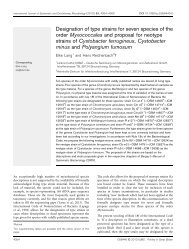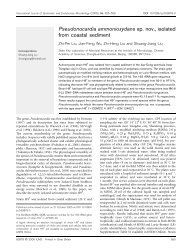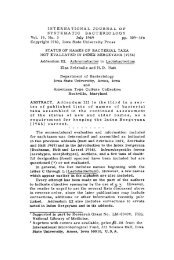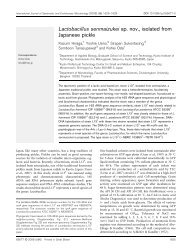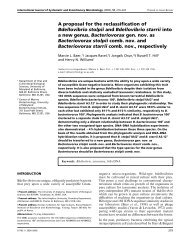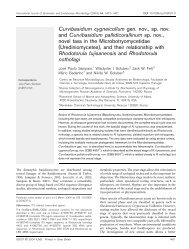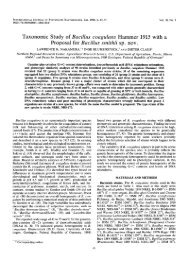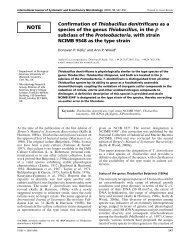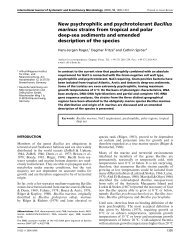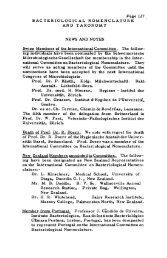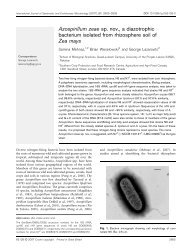Pichia insulana sp. nov., a novel cactophilic yeast from the Caribbean
Pichia insulana sp. nov., a novel cactophilic yeast from the Caribbean
Pichia insulana sp. nov., a novel cactophilic yeast from the Caribbean
You also want an ePaper? Increase the reach of your titles
YUMPU automatically turns print PDFs into web optimized ePapers that Google loves.
P. F. Ganter, G. Cardinali and K. Boundy-Mills<br />
crescit in digitonino et in cycloheximido at 0.1 p.p.m.<br />
Habitatio in cacti tribus Opuntieae, stipitibus subtribus<br />
Stenocereinae et stipitibus tribus Cereeae.<br />
Typus: stirps TSU00-106.5 T ex tabidosus sacculis cacti Cereus<br />
repandus isolata est. Stirps TSU00-106.5 T in collectione<br />
zymotica Centraalbureau voor Schimmelcultures, Delphi<br />
Batavorum sub no. CBS 11169 T et Phaff Yeast Culture<br />
Collection, Davis, CA, USA, sub no. UCD-FST 09-160 T<br />
deposita est.<br />
Description of <strong>Pichia</strong> <strong>insulana</strong> Ganter, Cardinali &<br />
Boundy-Mills <strong>sp</strong>. <strong>nov</strong>.<br />
<strong>Pichia</strong> <strong>insulana</strong> (in.su.la9na. L. fem. adj. <strong>insulana</strong> of or<br />
belonging to an island, referring to <strong>the</strong> isolation of strains<br />
<strong>from</strong> <strong>the</strong> island of Curaçao).<br />
Carbon sources assimilated are glucose, ethanol, Dglucosamine,<br />
lactic acid, succinic acid, citric acid and<br />
malic acid. Growth is delayed on glycerol and sometimes<br />
weak. None of <strong>the</strong> known strains grows on D-galactose, Lsorbose,<br />
maltose, sucrose, cellobiose, trehalose, lactose,<br />
melibiose, raffinose, melezitose, inulin, soluble starch, Dxylose,<br />
D- orL-arabinose, D-ribose, L-rhamnose, erythritol,<br />
adonitol (ribitol), dulcitol (galactitol), D-mannitol, Dsorbitol<br />
(D-glucitol), methyl a-glucoside, salicin, gluconod-lactone,<br />
5-ketogluconate, inositol, N-acetylglucosamine,<br />
glucuronic acid, hexadecane, methanol, ethyl acetate, 2propanol<br />
or acetone. Most strains demonstrate no ability<br />
to ferment, but three strains ferment glucose weakly (some<br />
gas in <strong>the</strong> Durham tubes) after 14 days. All strains grow at<br />
42 uC and on 5 % NaCl/0.5 % glucose medium, but not at<br />
10 % NaCl. The only nitrogen source assimilated strongly is<br />
ethylamine, but most strains grow weakly on lysine.<br />
Nitrogen sources not assimilated include KNO3 and<br />
KNO2. All known strains are susceptible to digitonin and<br />
0.1 p.p.m. cycloheximide. No tested strain shows any killer<br />
activity against Candida glabrata strain Y-55 (Starmer et<br />
al., 1987). After 3 days growth on YM agar (Difco), cells<br />
are <strong>sp</strong>herical to ellipsoid and approximately 2–364–7 mm<br />
(Fig. 2). Short pseudohyphae are rare on cornmeal agar<br />
after 10 days of growth. Three days’ growth in liquid YM<br />
medium (Difco) at 30 uC produces <strong>sp</strong>herical to ovoid cells,<br />
1.3–2.562.5–5 mm. Colonies grown on malt agar are<br />
cream-coloured, with a smooth, glistening surface and an<br />
even margin. Spores can be observed on YM agar (Difco)<br />
after 6–14 days. Six asci <strong>from</strong> strain TSU00-106.5 T were<br />
dissected, which yielded 18 <strong>sp</strong>ore clones. All four <strong>sp</strong>ores<br />
germinated <strong>from</strong> three asci but only two germinated <strong>from</strong><br />
<strong>the</strong> remaining three asci. Mating among <strong>the</strong> <strong>sp</strong>ore clones<br />
confirmed that <strong>the</strong> <strong>sp</strong>ecies is heterothallic, as all three<br />
complete asci segregated in <strong>the</strong> expected 2h + :2h 2 ratio<br />
(h + and h 2 symbolizing opposite mating types). Once<br />
opposite mating types are mixed, changes in <strong>the</strong> shape of<br />
vegetative cells (<strong>the</strong> appearance of subequatorial bulges<br />
characteristic of shmooing) and conjugation tube formation<br />
are observed within 1–7 days (reasons for <strong>the</strong> wide<br />
variation in <strong>the</strong> re<strong>sp</strong>onse time are not known). Spore<br />
Fig. 2. Cells and dehisced asci of <strong>Pichia</strong> <strong>insulana</strong> <strong>sp</strong>. <strong>nov</strong>.<br />
TSU00-106.5 T after 8 days on YM agar. (a) Vegetative cells; (b, c)<br />
isolated conjugants with conjugation tube visible; (d–h) dehisced<br />
asci with four hat-shaped <strong>sp</strong>ores.<br />
clones TSU00-106.5V and TSU00-106.5W were designated<br />
mating types h + and h 2 , re<strong>sp</strong>ectively. No mating between<br />
ei<strong>the</strong>r P. <strong>insulana</strong> mating type and <strong>the</strong> a<strong>sp</strong>orogenous strains<br />
<strong>from</strong> Curaçao, <strong>the</strong> six UC Davis strains or <strong>the</strong> mating types<br />
of P. pseudocactophila produces <strong>sp</strong>ores or gives any<br />
indication (shmooing or conjugation tube formation) of<br />
sexual activity.<br />
Strain TSU00-106.5 T (5CBS-11169 T 5UCD-FST 09-<br />
160 T ), collected <strong>from</strong> a rot pocket in a Cereus repandus<br />
cactus on <strong>the</strong> island of Curaçao, is <strong>the</strong> type strain. The<br />
mating type <strong>sp</strong>ore clones of TSU00-106.5 T are deposited at<br />
<strong>the</strong> Phaff Yeast Culture Collection, University of California<br />
Davis, Davis, CA, USA, as UCD-FST 09-161 (h+ clone)<br />
and UCD-FST 09-162 (h2 clone).<br />
1004 International Journal of Systematic and Evolutionary Microbiology 60



